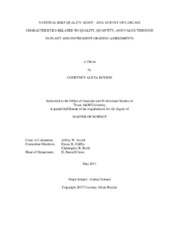| dc.description.abstract | The National Beef Quality Audit – 2016 included in-plant cooler and instrument grading assessments to benchmark the current status of the fed steer and heifer beef industry in the United States. In-plant cooler assessments (n = 9,106 carcasses) were conducted at 30 facilities across the United States. Approximately 10 percent of the day’s production were evaluated for USDA quality grade (QG) and yield grade (YG) factors. Frequencies of traits evaluated are as follow: steer (66.5%), heifer (33.4%) sex classes; native (81.6%), dairy-type (16.3%), and Bos indicus (1.4%) estimated breed types; and dark cutter (1.9%). Mean USDA YG factors were USDA YG (3.1), adjusted fat thickness (AFT; 1.42 cm), loin muscle (LM) area (89.5 cm^2), hot carcass weight (HCW; 390.3 kg), and kidney, pelvic, and heat fat (KPH; 1.9%). Frequency distribution of USDA YG were YG 1 (9.6%), YG 2 (36.7%), YG 3 (39.2%), YG 4 (12.0%), and YG 5 (2.5%). Mean USDA QG traits were USDA QG (Select^96), marbling (Small^70), overall maturity (A^64), lean maturity (A^55), and skeletal maturity (A^69). Frequency distributions of USDA QG were Prime (3.8%), Choice (67.3%), Select (23.2%), and lower score (5.6%). Marbling score distributions were Slightly Abundant or greater (0.85%), Moderate (7.63%), Modest (23.54%), Small (39.63%), Slight (23.62%), and Traces or less (0.83%)
One week of instrument grading data were collected each month from 5 beef processing corporations encompassing 18 facilities beginning January 2016 through December 2016 to allow the evaluation of seasonal trends (n = 4,544,635 carcasses). Mean USDA YG factors were USDA YG (3.1), AFT (1.37 cm), LM area (88.9 cm^2), HCW (393.6 kg), and KPH (1.9%). Frequency distribution of USDA YG were YG 1 (9.5%), YG 2 (34.6%), YG 3 (38.8%), YG 4 (14.6%), and YG 5 (2.5%). Monthly HCW means were as follows: January (397.6 kg), February (397.2 kg), March (396.5 kg), April (389.3 kg), May (384.8), June (385.0), July (386.1 kg), August (394.1 kg), September (399.1 kg), October (403.9 kg), November (403.2 kg), and December (401.9 kg). Monthly mean marbling scores were January (Small^73), February (Small^80), March (Small^81), April (Small^77), May (Small^70), June (Small^67), July (Small^70), August (Small^75), September (Small^74), October (Small^76), November (Small^83), and December (Small^79). Both mean HCW and marbling scores declined in the months of May and June. These data indicate the range of carcasses that are being produced currently. The findings from this study will be utilized by all segments of the industry to understand and improve the quality of fed steer and heifer beef that is being produced. | en |


